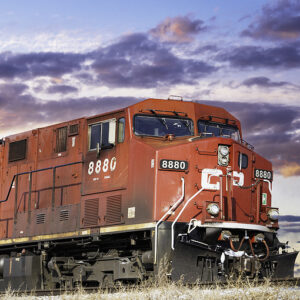Derailments like the tragic incident in East Palestine, Ohio, make the headlines, but industry observers say America’s freight rail industry is on track to move more goods and to do so more safely than any other form of transport.
The largest Class I railroads in the United States have been negotiating with employee unions over paid sick leave, schedule predictability and other issues in the months since a national rail strike was averted. In November, the House of Representatives voted to approve contracts that included a 24 percent pay increase over five years through 2024, an extra paid day off, and a separate resolution providing seven days of paid sick leave instead of just one.
As individual railroads continue negotiations, the head of the Association of American Railroads (AAR) said multiple railroads are inking deals to keep trains running and provide better employee benefits.
“Not all of these agreements are the same,” association CEO Ian Jefferies said. “However, they result from good-faith bargaining and a shared desire to demonstrate the value rail employees provide to their companies, their families, and the overall economy. For months, railroads have been at the table individually with their unions to find a path forward on the quality-of-life matters that came into the spotlight during the round’s final days.”
AAR noted that employment at Class 1 railroads — the largest railroads in the United States with revenues exceeding $900 million annually — has grown by 8.2 percent since January 2022 to 121,391, marking the highest level since April 2020. Most unionized employees have contracts that include paid sick leave and short- and long-term paid sickness benefits.
The association also said the typical union employee receives three weeks of paid vacation, with more senior-level employees receiving up to five weeks. The association said that is in addition to as many as 14 paid holidays and/or personal days.
As for safety concerns, Jefferies acknowledges that while the East Palestine derailment was tragic, it doesn’t reflect the actual level of safety in his industry.
“Let me make absolutely clear,” Jefferies told the House Subcommittee on Railroads, Pipelines, and Hazard Materials last month, “for freight railroads, pursuing safe operations is not an option; it’s an imperative.
“Every rail accident is one too many, and railroads’ ultimate goal is to eliminate accidents altogether,” Jefferies added. “Newly released data from the Federal Railroad Administration confirm that 2022 was the safest year for incidents involving hazardous materials and for mainline derailments. The overall train accident rate was 28 percent lower in 2022 than in 2000.”
An investigation by USA Today following the Ohio incident found “railway incidents requiring nearby residents to flee possible explosions or potentially toxic fumes are rare.” The paper also noted federal inspectors are citing railroads more for hazardous materials violations, which “appear to be climbing.”
AAR responds that “more than 99.9 percent” of hazardous materials moved by rail reach their destinations without incident.
The Federal Railroad Administration calls rail the “safest method” for moving large amounts of chemicals.
Still, in April, the Department of Transportation denied a special permit to New Fortress Energy to transport liquified natural gas by special trains outfitted to carry the flammable substance — a move cheered by environmentalists who have referred to such trains as “bomb trains.”
“It is hard to say why they decided to do what they did, but hopefully, the East Palestine disaster would make them look more closely at the transport of all hazardous and explosive materials across the country,” said Kim Ong, an attorney with the Natural Resources Defense Council.
On June 13, the National Governors Association, the National League of Cities, and the National Association of Counties sent a joint letter to Senate Majority Leader Chuck Schumer and Senate Minority Leader Mitch McConnell, asking them to push through the Railway Safety Act of 2023.
“Due to the increasing length of trains and, therefore, the consolidation of hazardous materials to more of these trains, each of the more than 1,164 derailments is a threat to the economic competitiveness of our cities and states,” the organizations wrote. “Without Congress’ help to secure passage of this bipartisan legislation, the U.S. Department of Transportation and state and local governments cannot move forward important oversight actions nor identify the full threat for our first responders. Each derailment is a potential disaster, and Congress should not wait any longer to act on bipartisan rail safety legislation that addresses key rail issues using reasonable and clear solutions.”
But Michael F. Gorman, the Niehaus chair in business analytics and operations management at the University of Dayton, said the legislation “misses the mark.” It would make rail shipments costlier and force companies to put hazardous materials on more dangerous trucks.
Rail operates in a “closed system” that dispatchers can manage and control, resulting in “fewer unexpected events and far fewer accidents,” he wrote in an opinion column for The Hill.
“Yes, because railcars are larger and many of them can be involved in a single incident, derailments or collisions can be spectacular, national events,” said Gorman, who consults with the rail industry. “However, truck accidents are 16 times more frequent, causing far more overall damage, injuries and deaths than the relatively rare but more easily recalled train events. During the last decade, truck incidents have doubled, while rail incidents have actually fallen by 40 percent.”
The Federal Railroad Administration “data makes clear that our employees’ strong safety culture, paired with the industry’s sustained, disciplined investments in maintenance and technologies that target the primary causes of accidents, deliver meaningful safety results,” Jefferies told the congressional committee. “Every train accident is one too many, and the need to make progress in the march to zero accidents is ever present.”


